Amezaiku—Art Born from the Fingertips
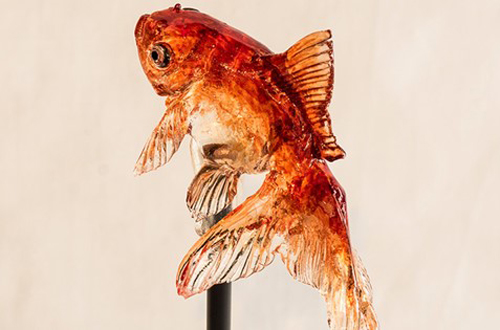
This goldfish looks as if it is about to move. This dynamic-looking creature is actually made of ame, a type of Japanese hard candy.
This is one of the amezaiku—Japanese candy sculptures in animal and other forms—that are made by Ameshin, a Tokyo-based company of candy sculpting artisans with skills that exceed most in Japan. IHCSA visited Mr. Shinri Tezuka, representative and head of the company, to see how he does his work and what he pursues as an artisan.
Candy Sculptures Developed into a Unique Style in Japan
Ame is said to have been introduced to Japan from continental Asia from the Nara Period (710–794) to the Heian Period (794–1185). As it was extremely valuable, ame was designed elaborately and handled as something truly special. Notably, it was served as a votive offering. As time went by, ame gradually became affordable for common people. In the Edo Period (1603–1868), street vendors began to sell ame at their open-air stands. Such ame vendors added designs to their goods to promote sales and add value. This is how amezaiku was developed into the Japanese style of today, in which scissors are used to carve out a figure.
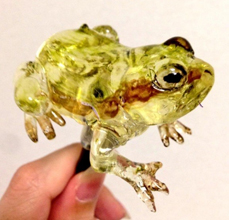
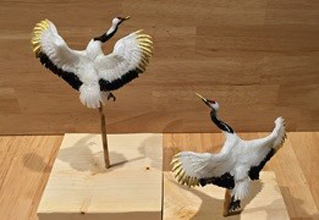
Candy sculpturing in many parts of the world has its own style. In Europe, candy sculptures are made by patissiers. In China, they are created without using scissors but by trickling melted candy down onto a flat plate. This is just one example of many candy sculpturing techniques in the world.
Figures That Cannot Be Redone
Amezaiku is made of a type of mizuame (clear and sticky candy) that is hard at normal room temperature. The sculpturing work begins by cutting off a 30- to 40-gram chunk from a lump of the candy that has been heated to some 90 degrees centigrade.

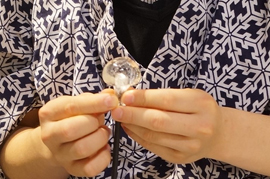
Mr. Tezuka fixes the chunk onto a thick, tube-like bar and does the sculpturing in one sitting. The time available for him is just five minutes or so. The melted candy begins to harden quickly from the surface. When it hardens, you cannot change the design. The amezaiku artisan makes a figure that he pictures in his mind with a preconceived set of processes. He uses his fingers to stretch the hot ame. He also uses scissors to pinch one end, then stands it up and etches fine lines on it. It seems as though a goldfish appears from the round chunk of ame in an instant. Mr. Tezuka adds skilled touches one after the other with no hesitation or wasted motion. The dexterity of his fingertips is riveting to the eyes.

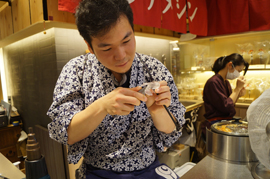
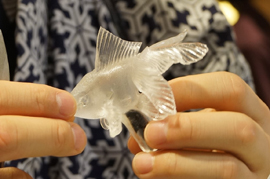
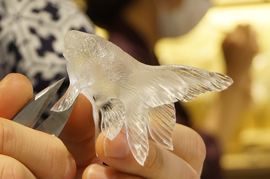
Now the shape is almost complete. Mr. Tezuka lets the figure cool in the air and moves on to the polishing and finishing processes.
Fingertips and Scissors
All amezaiku artisans have endured the experience of burning their fingertips many times. They have overcome this challenge by simply getting used to the heat. They can’t wear gloves because they have to complete the detailed work in a short period of time.


The scissors they use are similar to the type of Japanese U-shaped scissors that are used to cut thread in needlework. The differences are that the former are much larger and have a shape specifically designed for amezaiku. They are characterized by their quick and strong recoil, meaning that a strong grip is required to use them. A quick recoil is needed because candy sculptures must be made quickly. A strong recoil is needed because ame is sticky. Another characteristic is that the edges are so sharp that amezaiku artisans can pinch and stretch ame minutely. Because scissors that fit appropriately in the hand differ for each amezaiku artisan, they have to be custom-made; amezaiku artisans usually ask scissor-making artisans to come up with the perfect scissors for them through continuous improvement based on interactive communication.
Uncompromising Finishing
The finishing process involves heating the surface with an electric burner, which looks like a hair dryer. The added heat melts away the fine asperities that dull the surface, reviving the transparency and luster that are intrinsic to ame. Thorough and elaborate fine-tuning work at this stage involves adding fine patterns and enhancing the dynamism or looks of the lifelike figure.
Amezaiku are often modeled after a living creature. The texture of ame lends itself to depicting living creatures as it defies straight lines and regular angles.

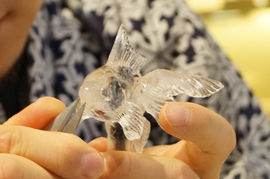
Coloring That Pursues Minute Details
The final process of coloring characterizes the craftsmanship of Ameshin’s amezaiku and makes their works one of a kind. The artisans mix food dyes of different colors on a palette and take time to apply them using a fine brush. They pursue the perfect combination of colors that matches the real thing and apply it to the clear material in such minute detail as to represent the real thing perfectly. At one glance, this particular work of a goldfish looks just like a real one, especially the complex surface patterns and the details of the eyes. It is just amazing that the lifelike work looks as if it is about to start swimming.
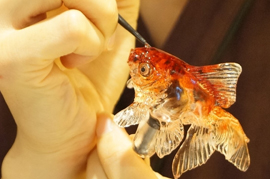
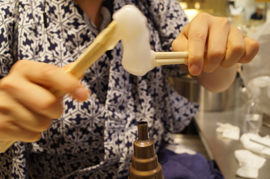
White amezaiku is also made of the same type of ame that is used for clear amezaiku; it is not made by adding a white dye to the material or painting the finished figure with white. Clear ame is made white by working it so that it absorbs air. The specific process is to take a chunk of ame onto the tip of a pair of bars, and then twist and pull it with another pair of bars while applying heat with a burner so that it takes in air bubbles. The sculpturing work is done in an instant, as in the case of the goldfish figure. The finishing touches makes the surface as glossy as the surface of clear ame. There is no difference in the coloring process.
Perfecting Expression in a Limited Period of Time
”The key is how much you can put into it of what you have in a short time,” says Mr. Tezuka. IHCSA asked him what some of the difficulties with making amezaiku are. Mr. Tezuka replied: “The molding and carving process must be finished in five minutes. Once it’s done, it’s done. If you can’t proceed with the work just the way you picture in your mind, the whole process will suffer. Each move must be designed so that it perfectly fits in the whole process. Many people might be able to create a decent work if they were given a whole day. But you have to make amezaiku in five minutes. That is the hardest part.”
”I always tell my apprentices, ‘the ability to see is way more important than the ability to make.’ You can improve your skills to a certain extent if you create many works. You may be able to make things well with such skills. But if you can’t really see the subject you are presenting, you can’t really see what you are making. In other words, input far outweighs output. Unless you clear this hurdle, there’s no way you can make good things.”

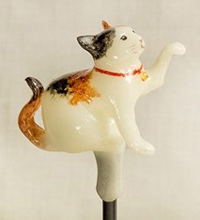
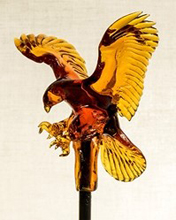
The Challenge of Handing Down Traditions in Japan Today
Mr. Tezuka continued: “In a sense, plugging away at monozukuri or making things like we do is unwanted in the age of affluence. Yet some such monozukuri endeavors begin to attract attention. My hope is that what I’m doing will help Japanese people to cherish Japanese traditions, younger generations to turn their attention to handcrafting, and people in other countries to take an interest in Japanese monozukuri.” As an inheritor of Japanese traditional culture, Mr. Tezuka has a sense of urgency. “The artisan who made my scissors has already retired. He has no successors to hand down his skills to. There were so many things in Japan that could be made only by hand. Such things are disappearing fast. Many of them are just being lost without anyone knowing it,” Mr. Tezuka said.

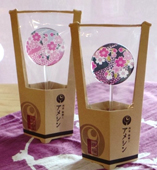

”Maintaining traditions is not just about continuing to do the same thing. It is more about improving and developing them in line with the times. Then one day, you look back and see that this process itself has become part of the traditions. All artisans have to maintain the desire to improve themselves. This will allow the traditions to develop forever. It will also create markets where artisans can do what they want to do. The existence of such markets will allow successors to inherit the traditions. Such an environment needs to be created by society as a whole; it’s not a question of whether or not to preserve the traditions. I hope I will be of some help in this regard. We basically follow the traditional processes, yet we also introduce new designs and make our works appealing to a wider audience. This is how we ‘preserve’ our traditions.”.

”There are still many things I cannot do. I want to clear such hurdles one by one. This is what artisanship is all about, you know. We’re ready to go beyond amezaiku. For example, we are thinking about introducing new materials. There is great potential before us. It offers many opportunities for us to learn. My job cannot be boring in that sense, and I enjoy it. There’s no end to it.”
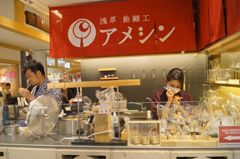
Thanks to, and photos courtesy of: Ameshin
Ameshin Website:</br >http://www.ame-shin.com/en/
■Tokyo Skytree Town Solamachi Store
For amezaiku demonstrations and sales
Block 11, East Yard, 4F, TOKYO Solamachi, TOKYO SKYTREE TOWN,
1-1-2 Oshiage, Sumida-ku, Tokyo, 131-0045
Nearest train stations:
Tokyo Skytree Station on the Tobu Line
Oshiage Station on the Toei Asakusa Line, the Keisei Oshiage Line,
and the Tokyo Metro Hanzomon Line
■Head Office in Asakusa
For amezaiku hands-on workshops
1F, 1-4-3 Imado, Taito-ku, Tokyo, 111-0024
A 10- to 15-minute walk from Asakusa Station on the Tokyo Metro Ginza Line, the Toei Asakusa Line, and the Tobu Line
